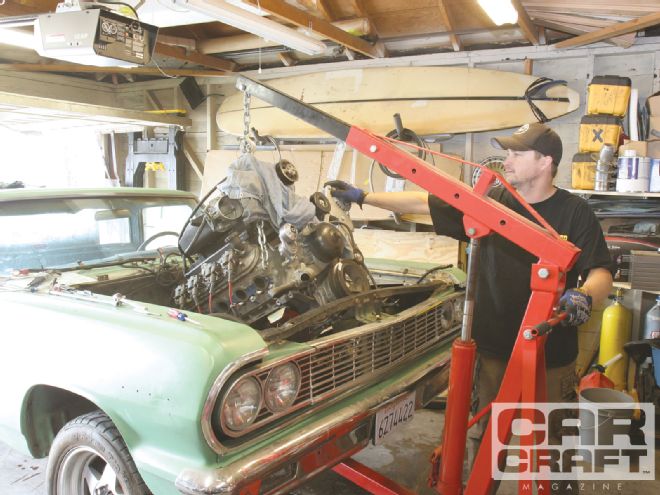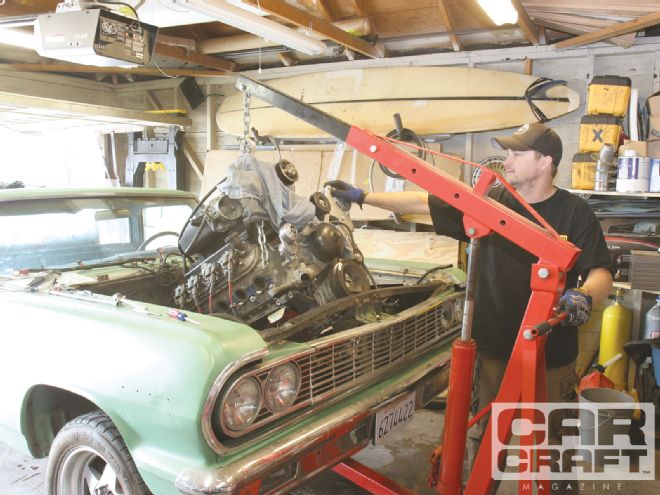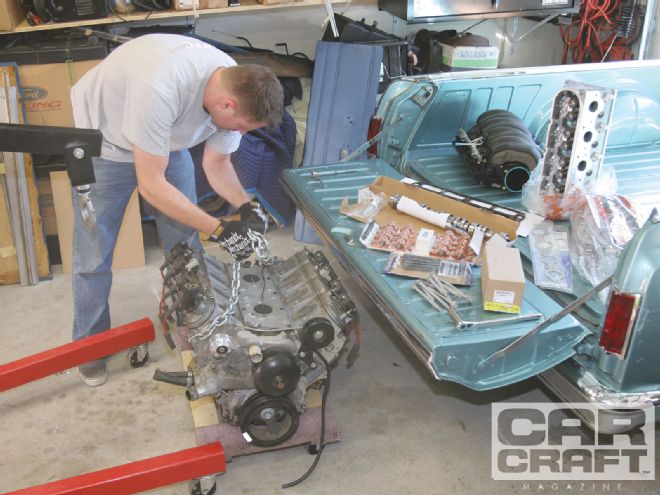
It took less than 30 seconds for the performance industry to respond to the power potential of the new generation of LS engines with a raft of cylinder heads, camshafts, and intake manifolds. Among the companies that offer parts, Trick Flow Specialties (TFS) has come up with a package called the GenX Top-End Engine Kit that includes a pair of complete CNC-ported cylinder heads, a matching hydraulic roller camshaft, pushrods, head bolts, and even head and exhaust gaskets that make the swap a bolt-on affair. TFS offers three different levels for the typical 346ci LS1 engine rated at 485, 500, and 515 hp. Because this is Car Craft, we chose a slightly different route, using TFS Fast As Cast heads with the second-biggest cam.
 The easiest way to swap the heads and cam is to yank the motor. A head swap is easy in the car, but the cam generally won't clear the early Chevelle grille unless you pull virtually the entire assembly out of the car. Frankly, to change the cam, it's easier to yank the motor.
The easiest way to swap the heads and cam is to yank the motor. A head swap is easy in the car, but the cam generally won't clear the early Chevelle grille unless you pull virtually the entire assembly out of the car. Frankly, to change the cam, it's easier to yank the motor.
Our volunteer victim for this quick horsepower upgrade was none other than the '04 GTO LS1 engine that has been quietly hiding in Editor Glad's '64 El Camino. He yanked the motor and, along with a pile of shiny new parts, dropped it in the back of our little blue Project S-10 pickup for the trip out to Westech's SuperFlow engine dyno/polygraph room. The LS1 made an impressive 414 hp on the baseline run, but it was the near-500 hp we made with just a swap of cam and heads that made the biggest impression. And we made all this power on pump gas.
The LS1
The phrase LS engine has been overused to the point that it has become almost meaningless. But in our case, our test victim truly is an LS1 that was originally destined for use in an '04 GTO before a detour found it in Editor Glad's green-hued El Guapo ("How To Swap a Gen III into a '64-'72 A-Body" May '08). Glad's only change to the engine was to add a Street & Performance oil pan to clear the engine crossmember. For the purposes of our test, we yanked the EFI manifold, replacing it with a carburetor mainly to make the test easier and minimize the electronic hassles. The factory rates this 10.2:1-compression, 346ci engine at 345 hp at 5,200 and 345 lb-ft at 4,800. With a 3.89-inch bore and a 3.62-inch stroke, it is considered a small-bore engine. Despite the small bore, it is capable of some impressive power numbers. The easiest way to make power is to add cam timing, since the stock LS1 cams measure in at 198 degrees at 0.050-inch tappet lift with around 0.475 inch of valve lift. As you'll see, with the addition of just an Edelbrock intake, a Holley 750-cfm carb, and a set of headers, even a stock LS1 is capable of more than 400 hp.
 Here's our LS1 motor ready for the dyno with the TFS GenX system parts arrayed on the tailgate of Glad's '65 El Camino.
Here's our LS1 motor ready for the dyno with the TFS GenX system parts arrayed on the tailgate of Glad's '65 El Camino.
The TFS GenX Top-End Kit
The simple elegance of the TFS kit is that the company has done the work of dyno-matching the components for you with three different horsepower levels based on cam timing and cylinder heads. The kits range in horsepower ratings from 485 to 515. In our case, we used a pair of TFS Fast As Cast 220cc intake port cathedral-port heads to save a little money compared with the CNC-ported heads. These heads offer a valve size small enough to not interfere with the LS1's rather small bore size, yet the intake ports will flow 300 cfm at 0.600-inch lift. Combine the high-velocity intake port flow with a camshaft that's 30 degrees longer in duration, and you have the makings of a pretty solid performance package. The cylinder heads come with a 13.5-degree valve angle, which is even more vertical than the 15-degree production heads. And they are equipped with dual valvesprings that are installed with 150 pounds of seat load and 438 pounds of open pressure and can handle up to 0.600-inch valve lift. Combine that with a set of titanium retainers that help keep the weight down, and we have all we need to make some serious power. With the dual valvesprings' larger upper diameter, TFS also had to include a set of Harland Sharp 1.7:1 roller rockers with the kit because the OE rockers will not clear the bigger springs.
You may notice that the camshaft appears to be somewhat conservative on duration, but our experience with high-flow cylinder heads like these TFS castings is that less duration is required to make the same power at higher engine speeds. This is mainly due to the more efficient cylinder heads that flow much more air, therefore allowing the engine (even with a shorter-duration cam) to push the peak horsepower rpm point a little higher in the power curve. The advantage to using a shorter-duration cam is that the lower and midrange power is better with a shorter cam, which means the car will accelerate better from a tight converter launch.
CAM SPECS CAMSHAFT DURATION (ADV.) DURATION (0.050) (LIFT INCHES) LOBE SEPARATION '01-'03 OE LS1 cam, intake N/A 198 0.467 116 Exhaust N/A 207 0.479 TFS Track Max, intake 283 228 0.585 112 PN 30602003, exhaust 286 230 0.585
TFS offers a total of four different camshafts. We won't list them all, but the '03 cam we used is second from the longest in duration. The biggest cam, intended for the LS2 engines, pushes the envelope with 238/242 degrees at 0.050 and 0.595-inch lift. This might help with max power, but it will also push the peak horsepower close to 6,800 rpm, which will eventually hurt the cast-aluminum pistons. For the larger cam, a set of forged pistons is highly recommended.
Test Day
After we loaded up the LS1 motor on Westech's dyno along with the dual-plane Edelbrock intake and the matching Edelbrock timing module, we were ready for our initial testing. But right off the mark, the engine sounded out of tune. After a little diagnostic work, Westech's Steve Brulé discovered a major vacuum leak at the intake gaskets. To solve our problem, we had to stack a pair of Fel-Pro gaskets. This situation is not uncommon because Fel-Pro makes three different gasket thicknesses (0.030, 0.045, 0.090 inch) to accommodate it.
Once we had the intake sealed properly, the motor pulled nicely through the powerband, making a peak of 414 hp at 6,400 rpm-much higher than the stock 5,200. We attribute this to the unrestricted intake and exhaust, since we were using a set of Kooks 13/4-inch stainless headers with 18-inch collector extensions and no mufflers. This might be further reinforced by the fact that peak torque did not alter from its factory 4,000-rpm set point, which actually makes the powerband between peak torque and peak horsepower an amazingly wide 2,400 rpm. Once we had the baseline set, we pounced on the poor LS1, and in about an hour, we swapped the heads, changed cams, and had everything buttoned back up and ready to run.
Here is where the fun began. The Edelbrock timing module uses plug-in chips that represent different timing curves. We used the No. 2 module, which offers up 36 degrees of total timing. Frankly, all the modules eventually employ the same total timing of 36 degrees, with the differences mainly in how quickly the low-speed curves build to max timing. Unlike the MSD 6010 timing module, the Edelbrock module does not allow changes to the curves using a laptop computer, so we couldn't alter the timing. It's possible we could have made slightly more peak power had we been able to lower the total timing. As far as jetting was concerned, we leaned the total air/fuel ratio about a half ratio, but the power remained the same.
After the first two pulls on our new combination, our LS1 made its best power with a 499hp peak, and torque came in at 455 lb-ft at 5,400 rpm. The longer-duration cam obviously pushed the peak torque up 1,400 rpm, but the peak horsepower rpm remained at 6,400, which means the midrange torque jumped dramatically. If you look closely at the numbers, you can see 60-plus lb-ft of torque gains in the midrange. That is something you can feel in the seat of your pants every time you hit the throttle. Sure, the headline 85hp gain at the top with 499 hp is cool, but it's that major torque improvement in the middle that will move your car much quicker down the 1,320.
We tried really hard to push the little LS1 into the 500hp zone with the dual-plane intake, but it just couldn't cross over. We bolted on an Edelbrock LS1, Victor Jr. single-plane expecting a rather sizeable improvement in peak power. While the LS1 did pop up to 506 hp, it was clear from the torque loss due to the shorter intake runner length that this particular combination would be far happier, quicker, and more fun to drive with the dual-plane.
Dyno Test Results
Test 1 was the baseline test using the stock LS1 '04 GTO engine configuration enhanced with a set of 1 3/4-inch chassis headers, an Edelbrock cathedral-port carbureted dual-plane Performer RPM intake manifold, and a Holley 750-cfm HP-style mechanical-secondary carburetor.
Test 2 is the big test with the addition of the TFS Fast As Cast 220cc heads, a bigger hydraulic camshaft, stronger pushrods, and the matching Harland Sharp net-lash rocker arms. Note that peak torque and horsepower rpm points didn't change very much while adding a sizable amount of power in the usable rpm range.
Test 3 is where we thought we could push this package above 500 hp by using a single-plane intake manifold. While we did accomplish that goal, the peak horsepower gain wasn't worth the major torque loss between 3,000 and 4,800.
RPM TQ1 HP1 TQ2 HP2 TQ3 HP3 GAIN (TEST 1 VS. 2) TQ HP 3,000 387 221 414 236 358 205 27 15 3,200 385 234 416 253 357 218 31 19 3,400 392 254 431 279 374 242 39 25 3,600 401 275 440 302 396 271 39 27 3,800 404 292 444 321 410 297 40 29 4,000 406 310 451 343 416 317 45 33 4,200 406 325 453 363 419 335 47 38 4,400 403 338 452 379 422 353 49 41 4,600 400 350 450 394 431 377 50 44 4,800 398 364 448 409 446 408 50 45 5,000 395 376 447 425 450 428 52 49 5,200 389 386 448 444 450 445 59 58 5,400 384 395 451 463 455 467 67 68 5,600 378 403 445 474 450 480 67 71 5,800 370 408 436 481 441 487 66 73 6,000 359 410 428 489 432 493 69 79 6,200 351 414 420 496 424 500 69 82 6,400 340 414 409 499 415 506 69 85 6,600 - - 389 489 397 499 - - Peak 406 414 453 499 455 506 Average 385.4 345.6 436.6 398.1 420.2 380.3
Averages taken every 100 rpm between 3,000 and 6,400 for all four tests.
Note how even though Test 4 made more peak power, the average torque of Test 3 versus Test 4 is 16.6 lb-ft per rpm point greater. At 3,200 rpm, for example, the dual-plane makes 59 lb-ft more torque. That's too big a number to ignore!
PARTS LIST DESCRIPTION PN SOURCE PRICE TFS GenX LS1 Top-End kit K306-515-460 Summit Racing $3,299.95 TFS 220 as-cast LS1 cylinder head 3060T001 Summit Racing 1,699.95 TFS 215 CNC-ported LS1 heads 3060T001-C02 Summit Racing 2,395.95 TFS Track Max roller camshaft 30602003 Summit Racing 349.95 TFS chrome-moly pushrods 21407500 Summit Racing 86.95 Harland Sharp 1.7:1 roller rockers SLS17 Summit Racing 379.95 Head bolt kit '98-'03 LS engines 12498545 Summit Racing 25.95 (2) Head bolt kit '04-later LS engines 17800568 Summit Racing 25.95 (2) GMPP crank bolt 12557840 Summit Racing 4.95 GMPP head gaskets, LS1 12498544 Summit Racing 32.95 Fel-Pro 0.090-thick intake gaskets 1312-4 Summit Racing 31.99 GMPP exhaust gaskets 12617944 Summit Racing 20.39 (2) Edelbrock LS1 intake and ignition kit 7118 Summit Racing 669.95 Holley 750-cfm HP mech. sec. 0-80528-1 Summit Racing 665.95 TFS roller timing chain 30678533 Summit Racing 129.95